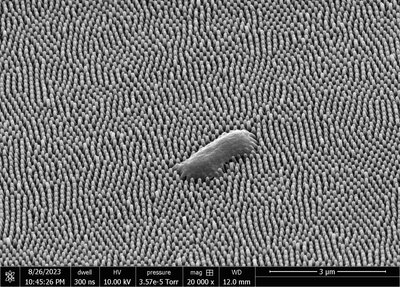
At this year’s Society for Integrative & Comparative Biology (SICB) Conference, Entomology Assistant Professor Marianne Alleyne and graduate student Yutao Chen showcased their research on the unique properties of insect wings. Their work, part of Yutao's graduate studies, explores how microscopic structures on insect wings could inspire innovative ways to combat bacterial infections. The presentation was featured in Science, a prominent online publication.
Alleyne and Chen’s research focuses on the extraordinary antibacterial properties of cicada wings, which are covered with microscopic pillars—known as "nanopillars"—visible only under an electron microscope. These structures have the remarkable ability to kill bacteria upon contact. When microbes move across these nanopillars, the flexible pillars bend under the bacteria's weight, puncturing their membranes and effectively destroying them.
To better understand this natural phenomenon, Alleyne and Chen are developing synthetic models of cicada wings. Their process involves creating aluminum molds with wells of varying depths, which are then filled with a thin layer of polystyrene. Once the aluminum is dissolved, what remains is a polystyrene platform patterned with nanopillar features.

Chen produced two versions of these synthetic nanopillars: one that matches the size of the natural structures on cicada wings and another slightly larger. To test their antibacterial effectiveness, she exposed the nanopillars to Pseudomonas, a bacterium known to cause pneumonia, urinary tract infections, and blood infections.
The results were groundbreaking. Using a fluorescent dye system that marks live bacteria as green and dead bacteria as red, Chen found that the smaller synthetic nanopillars killed 98% of the bacteria within three hours, rivaling the effectiveness of bleach—a widely used disinfectant. Meanwhile, the larger nanopillars still achieved an impressive 89% kill rate.
This research not only advances our understanding of natural antibacterial mechanisms but also has potential applications in fields ranging from medical device coatings to infection-resistant surfaces. By mimicking the unique properties of insect wings, Alleyne and Chen are paving the way for innovative approaches to preventing infections and improving public health.